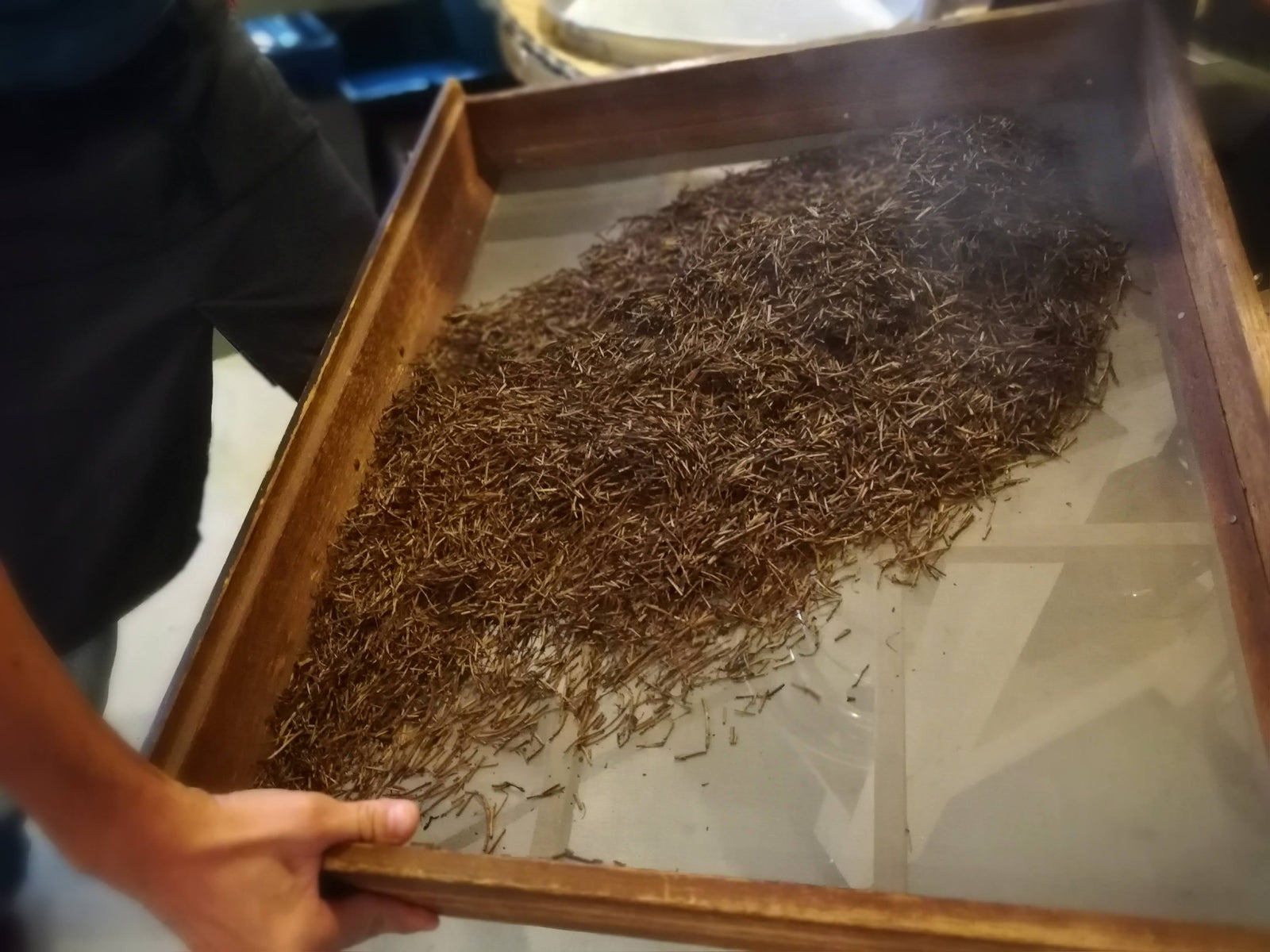日本人の間で昔から愛され、人気が衰えないお茶の一つがほうじ茶です。京都発祥の緑茶で、焙じたお茶です(その歴史については別の記事で触れます!)。 煎茶とは対照的に、ほうじ茶はカフェイン含有量が少ないため、子供からお年寄りまで、そして夕方から夜にかけても好んで飲まれています。
最近、同じ植物( カメリウス・セニシス)から作られているのに、なぜほうじ茶はカフェインが少ないのかと聞かれました。正直なところ、ほうじ茶を日常的に飲んで育った私にとって、この疑問は頭に浮かびませんでした。しかし、最初に考えたのは、ほうじ茶の焙煎工程が、他の日本茶(例えば煎茶)の蒸し製法とは異なるためではないかということでした。さらに調べてみると、ほうじ茶のカフェイン含有量が少ないのは、主に3つの要因によるものであることがわかりました。
まず、茶葉を高温で焙煎するという工程については、私の考えは正しかったです。具体的には、ほうじ茶を作る際、茶葉は160~220℃(焙煎の濃さによって異なります)で焙煎されます。これは通常、カフェインの昇華沸点である178℃を超えることを意味します。つまり、カフェインは蒸発し、茶葉に含まれるカフェイン含有量が減少します。この焙煎技術によって、ほうじ茶は赤褐色になり、甘く土っぽい香りが生まれます。ただし、焙煎方法(例えば、炭火焙煎ではなく、回転する金属樽を加熱するガス火など)、焙煎時間と火力(その日の気温や湿度にも影響されます)、そして使用する茶葉などによって、風味は大きく異なることに注意してください。
下:徳島県有瀬村を拠点とするアメリカ人茶農家ヤンシーさんが、炭火でほうじ茶を淹れています。 浅煎りのほうじ茶は、繊細な味わいでありながら、穏やかで落ち着いた夜にぴったりです。
ほうじ茶のカフェイン含有量に影響を与える2つ目の要因、つまり、ほうじ茶を作るのに使われる茶葉の種類について考えてみましょう。煎茶、玉露、ほうじ茶はすべて同じ茶樹から作られますが、ほうじ茶は、夏や秋に収穫された二番茶や三番茶など、比較的遅い時期に収穫された、大きく成熟した葉から作られることが多いです。一般的に、煎茶や玉露のような一番茶を作るには、早い時期に収穫された一番茶(例えば、春に収穫された一番茶)が使われます。時間をかけて成熟し、成長した遅い時期に収穫された葉は、カフェイン含有量が低くなります。
最後に、ほうじ茶には茎や小枝が含まれることが多く、これらにはカフェインが非常に少なく含まれているため、最終製品のカフェイン含有量が薄められてしまいます。

2 種類のほうじ茶を並べた画像:左: 喜六茶園の在来晩春収穫ほうじ茶。 ザイライは特定の品種ではありませんが、現在日本では非常に珍しい品種です。右:善香園の茎ほうじ茶。番茶の最終収穫時の茎・茎のみを使用して特別に作られています。 くき茶ほうじ茶はカフェインが一番少ない!
並べて比較した画像からもわかるように、ほうじ茶は茶葉の種類や部位、刻み方、ふるい分け方、焙煎方法など、様々な要素によって見た目が全く異なります。Yunomi で提供される豊富なほうじ茶コレクションを見れば、その見た目の違いはさらに明らかになります。
まとめると、ほうじ茶にカフェインが少ない理由は3つあります。
- 焙煎工程
- 収穫期
- 茎と小枝(葉以外の部分)
さらに、私のように実際の数値やデータをご覧になりたい方は、こちらをご覧ください!標準的な量のほうじ茶1杯(250ml)には、約7.7mgのカフェインが含まれています。ほうじ茶のカフェイン含有量は、コーヒー、抹茶、煎茶よりも低いため、カフェインに敏感な方や、特に一日の後半にカフェイン摂取量を減らしたい方にとって、良い代替品となります。
以下に、様々な種類の日本茶のカフェイン含有量を具体的に調べた日本の研究データを示します(1)。これは1つの研究に基づいたデータであり、集計データではないことにご注意ください。また、どの研究にも限界があることにご注意ください。それでも、この研究データを用いて、様々な日本茶のカフェイン含有量の相対的な傾向を視覚的に把握していただけるよう、図解で示しました。

注:これらは一般的な数値であり、カフェイン含有量はこの記事で触れられているいくつかの要因によって異なります。
ほうじ茶はカフェインが全く含まれていないわけではありませんが、午後や夜に飲んでも睡眠を妨げることなく飲める程度にはカフェイン含有量は低いです(カフェインに極度に敏感な方を除いて)。しかし、先ほども述べたように、ほうじ茶の風味や香りは、様々な要因によって大きく異なります。とはいえ、もしほうじ茶がお好きなら、ぜひ色々な種類のほうじ茶を試してみてください!私も、自分のお茶のレパートリーに加えたい、風味豊かなほうじ茶を常に発見しています。午後や夜を明るくしてくれる、ささやかながらも意義深い喜び。きっと私の「喜びの本(2)」に載るでしょう。乾杯!
参考文献:
- 後藤 剛・長島 秀・吉田 雄・木曽 正之 (1996). 日本緑茶中の茶カテキンおよびカフェイン含有量.茶業研究報告, 1996 (83), 21-28.
- ゲイ、R. (2019). 『喜びの書:エッセイ集』アルゴンキン・ブックス.
アイキャッチ画像:ほうじ茶を焙煎する小倉茶園。写真:村田祥子
ほうじ茶について他にご質問がございましたら、お気軽に下記にコメントやご質問を投稿してください。または、私(岸田萌絵)まで直接ご連絡ください:moe@yunomi.life


